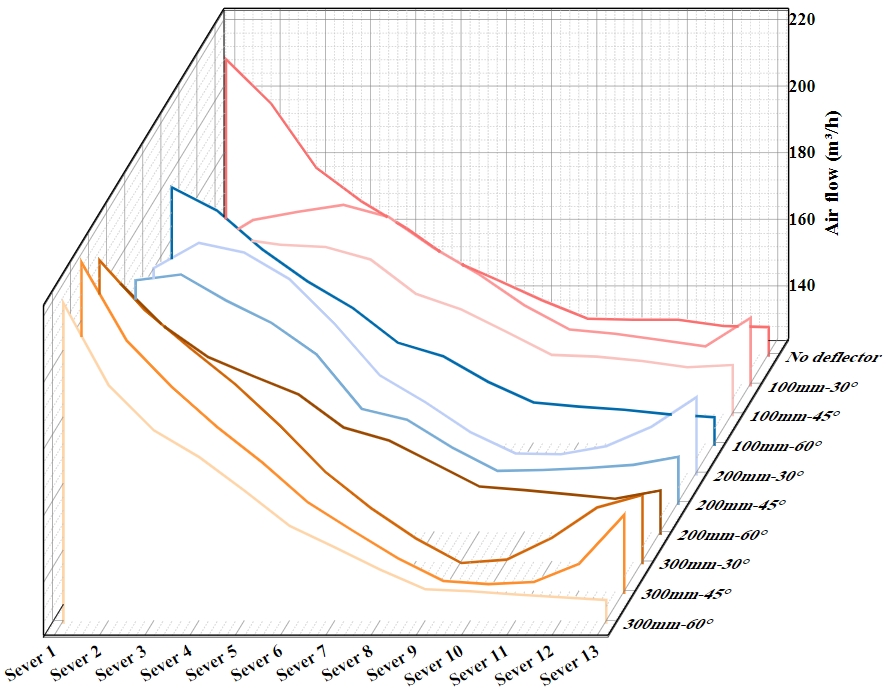Simulation and experimental research on the optimization of airflow organization and energy saving in data centers using air deflectors
DOI:
https://doi.org/10.18686/cest.v2i1.141Keywords:
data center; airflow organization; ANSYS simulation; deflector; energy efficiency improvementAbstract
The airflow organization of the data center directly affects the temperature control performance and the energy efficiency of the cooling equipment. The servers at the bottom of the rack usually suffer from insufficient airflow rate and poor cooling effect. This is because of the limited distance between the bottom servers and the perforated floor, and the small horizontal velocity of the supply air flow. This study aims to improve the uniformity of the cooling airflow in the vertical direction of the rack by the air deflectors, thereby further improving the overall airflow organization in the data center. The size and installation of the deflectors in the data center were optimized according to both the experiment and numerical simulation results. From the results, it is recommended to install the deflector with a width of 100 mm at an angle of 45° under the perforated floor for the rack with the single-side airflow supply. For the rack with the double-side airflow supply, the width of the deflector should be 100 mm and installed at an angle of 30° to the perforated floor to achieve the best airflow distribution. Consequently, the intake airflow rate for the bottom servers significantly increased, and the occurrence of the local hot spots was effectively reduced. The numerical simulation of the airflow organization with and without the deflector was conducted by ANSYS. The results show that, the installation of the deflectors increased the inlet airflow rate for the rack by 16.98% and improved the energy efficiency of the dater center air conditioners by 1.98%.

Downloads
Published
How to Cite
Issue
Section
License
Copyright (c) 2024 Boyang Ma, Haiyong Liu, Yahui Du, Xiaochen Yang, Zhihua Zhou, Jie Lu, Ying Chen

This work is licensed under a Creative Commons Attribution 4.0 International License.
References
1. China Refrigeration Society Data Center Cooling Working Group. China Data Center Cooling Technology Annual Development Research Report 2019 (Chinese). China Architecture & Building Press; 2020.
2. Ajayi O, Heymann R. Data centre day-ahead energy demand prediction and energy dispatch with solar PV integration. Energy Reports. 2021; 7: 3760–3774. doi: 10.1016/j.egyr.2021.06.062 DOI: https://doi.org/10.1016/j.egyr.2021.06.062
3. Du Y, Zhou Z, Yang X, et al. Dynamic thermal environment management technologies for data center: A review. Renew Sustain Energy Rev. 2023; 187: 113761. doi: 10.1016/j.rser.2023.113761 DOI: https://doi.org/10.1016/j.rser.2023.113761
4. Ristic B, Madani K, Makuch Z. The water footprint of data centers. Sustain. 2015; 7: 11260–11284. doi: 10.3390/su70811260 DOI: https://doi.org/10.3390/su70811260
5. Shehabi A, Horvath A, Nazaroff W, et al. Energy implications of economizer use in California data centers. In: Proceedings of the 2008 ACEEE Conference, Asilomar Conference Center; 17–22 August 2008; Pacific Grove, CA, USA. pp. 319–30.
6. Ni J, Jin B, Zhang B, Wang X. Simulation of thermal distribution and airflow for efficient energy consumption in a small data centers. Sustain. 2017; 9: 1–16. doi: 10.3390/su9040664 DOI: https://doi.org/10.3390/su9040664
7. Wang Y, Zhao W, Zhang J. Data center energy supply under the Energy Internet (Chinese). Energy. 2020, (5): 61–65.
8. Green Grid. PUE: A comprehensive examination of the metric. GreenGrid. 2012; 2012: 1–83.
9. Dai J, Ohadi MM, Das D, et al. Optimum Cooling of Data Centers. Springer New York; 2014. doi: 10.1007/978-1-4614-5602-5 DOI: https://doi.org/10.1007/978-1-4614-5602-5
10. Zhang G. Current status of data center energy consumption and energy-saving technologies (Chinese). Proceedings of the 2011 Modern Data Center Infrastructure Construction Technology Annual Conference of China Power Supply Society. 2011, 99–120.
11. Gözcü O, Özada B, Carfi MU, Erden HS. Worldwide energy analysis of major free cooling methods for data centers. In: Proceedings of the 2017 16th IEEE Intersociety Conference on Thermal and Thermomechanical Phenomena in Electronic Systems (ITherm); 30 May–02 Jun 2017; Orlando, FL, USA. pp. 968–976. DOI: https://doi.org/10.1109/ITHERM.2017.7992592
12. Zhao R, Du Y, Yang X, et al. A critical review on the thermal management of data center for local hotspot elimination. Energy and Buildings. 2023, 297: 113486. doi: 10.1016/j.enbuild.2023.113486 DOI: https://doi.org/10.1016/j.enbuild.2023.113486
13. Cho J, Yang J, Park W. Evaluation of air distribution system’s airflow performance for cooling energy savings in high-density data centers. Energy and Buildings. 2014, 68: 270-279. doi: 10.1016/j.enbuild.2013.09.013 DOI: https://doi.org/10.1016/j.enbuild.2013.09.013
14. Nadjahi C, Louahlia H, Lemasson S. A review of thermal management and innovative cooling strategies for data center. Sustainable Computing: Informatics and Systems. 2018, 19: 14-28. doi: 10.1016/j.suscom.2018.05.002 DOI: https://doi.org/10.1016/j.suscom.2018.05.002
15. Karki KC, Patankar SV. Airflow distribution through perforated tiles in raised-floor data centers. Building and Environment. 2006, 41(6): 734-744. doi: 10.1016/j.buildenv.2005.03.005 DOI: https://doi.org/10.1016/j.buildenv.2005.03.005
16. Bhopte S, Agonafer D, Schmidt R, et al. Optimization of data center room layout to minimize rack inlet air temperature. Journal of Electronic Packaging. 2006, 128(4): 380-387. doi: 10.1115/1.2356866 DOI: https://doi.org/10.1115/1.2356866
17. Nada SA, Said MA. Comprehensive study on the effects of plenum depths on air flow and thermal managements in data centers. International Journal of Thermal Sciences. 2017, 122: 302-312. doi: 10.1016/j.ijthermalsci.2017.09.001 DOI: https://doi.org/10.1016/j.ijthermalsci.2017.09.001
18. Nagarathinam S, Fakhim B, Behnia M, et al. A comparison of parametric and multivariable optimization techniques in a raised-floor data center. Journal of Electronic Packaging. 2013, 135(3). doi: 10.1115/1.4023214 DOI: https://doi.org/10.1115/1.4023214
19. Patankar SV, Karki KC. Distribution of cooling airflow in a raised-floor data center. ASHRAE Trans. 2004; 110: 629–634.
20. Sorell V. The Oft-forgotten component of air flow management in data center applications. ASHRAE Trans. 2011; 117: 427–432.
21. Rambo J, Nelson G, Joshi Y. Airflow distribution through perforated tiles in close proximity to computer room air-conditioning units. ASHRAE Trans. 2007; 113(PART 2): 124–135.
22. VanGilder JW, Pardey ZM, Healey CM. Measurement of perforated tile airflow in data centers. ASHRAE Conf. 2016; 122: 88–98.
23. VanGilder JW, Sheffer ZR, Zhang X, Healey CM. Potential flow model for predicting perforated tile airflow in data centers. ASHRAE Trans. 2011; 117: 771–786.
24. Nada SA, Elfeky KE, Attia AMA, et al. Experimental parametric study of servers cooling management in data centers buildings. Heat and Mass Transfer. 2017, 53(6): 2083-2097. doi: 10.1007/s00231-017-1966-y DOI: https://doi.org/10.1007/s00231-017-1966-y
25. Kang S, Schmidt RR, Kelkar KM, et al. A methodology for the design of perforated tiles in raised floor data centers using computational flow analysis. IEEE Transactions on Components and Packaging Technologies. 2001, 24(2): 177-183. doi: 10.1109/6144.926380 DOI: https://doi.org/10.1109/6144.926380
26. Karki KC, Radmehr A, Patankar SV. Use of computational fluid dynamics for calculating flow rates through perforated tiles in raised-floor data centers. HVAC&R Research. 2003; 9(2): 153-166. doi: 10.1080/10789669.2003.10391062 DOI: https://doi.org/10.1080/10789669.2003.10391062
27. Nada SA, Said MA, Rady MA. Numerical investigation and parametric study for thermal and energy management enhancements in data centers’ buildings. Applied Thermal Engineering. 2016; 98: 110-128. doi: 10.1016/j.applthermaleng.2015.12.020 DOI: https://doi.org/10.1016/j.applthermaleng.2015.12.020
28. Arghode VK, Sundaralingam V, Joshi Y. Airflow management in a contained cold aisle using active fan tiles for energy efficient data-center operation. Heat Transfer Engineering. 2015; 37(3-4): 246-256. doi: 10.1080/01457632.2015.1051386 DOI: https://doi.org/10.1080/01457632.2015.1051386
29. Makwana YU, Calder AR, Shrivastava SK. Benefits of properly sealing a cold aisle containment system. In: Proceedings of the Fourteenth Intersociety Conference on Thermal and Thermomechanical Phenomena in Electronic Systems (ITherm); 27–30 May 2014; Orlando, FL, USA. pp. 793–797. doi: 10.1109/itherm.2014.6892362 DOI: https://doi.org/10.1109/ITHERM.2014.6892362
30. Tatchell-Evans M, Kapur N, Summers J, et al. An experimental and theoretical investigation of the extent of bypass air within data centres employing aisle containment, and its impact on power consumption. Applied Energy. 2017; 186: 457-469. doi: 10.1016/j.apenergy.2016.03.076 DOI: https://doi.org/10.1016/j.apenergy.2016.03.076
31. Manoch Lukáš, Novotný Jan, Nováková Ludmila. Investigation of flow in data rack. Journal of Civil Engineering and Architecture. 2012; 6(12). doi: 10.17265/1934-7359/2012.12.012 DOI: https://doi.org/10.17265/1934-7359/2012.12.012
32. Phan, L, Hu, B, Lin, C. Air flow velocity field validation and turbulence studies on a single rack model in data centers. In: Proceedings of the ASME 2018 International Mechanical Engineering Congress and Exposition. Volume 8A: Heat Transfer and Thermal Engineering; 9–15 November 2018; Pittsburgh, Pennsylvania, USA. doi: 10.1115/IMECE2018-86575 DOI: https://doi.org/10.1115/IMECE2018-86575
33. Wang CH, Tsui YY, Wang CC. Airflow management on the efficiency index of a container data center having overhead air supply. J Electron Packag Trans ASME. 2017; 139: 1–10. doi: 10.1115/1.4038114 DOI: https://doi.org/10.1115/1.4038114
34. Alkharabsheh S, Sammakia B, Murray B, et al. Experimental characterization of pressure drop in a server rack. In: Proceedings of the Fourteenth Intersociety Conference on Thermal and Thermomechanical Phenomena in Electronic Systems (ITherm); 27–30 May 2014; Orlando, FL, USA. pp. 547–556. doi: 10.1109/itherm.2014.6892329 DOI: https://doi.org/10.1109/ITHERM.2014.6892329
35. Jin C, Bai X, Yang C. Effects of airflow on the thermal environment and energy efficiency in raised-floor data centers: A review. Science of The Total Environment. 2019, 695: 133801. doi: 10.1016/j.scitotenv.2019.133801 DOI: https://doi.org/10.1016/j.scitotenv.2019.133801
36. Wang N, Zhang J, Xia X. Energy consumption of air conditioners at different temperature set points. Energy and Buildings. 2013, 65: 412-418. doi: 10.1016/j.enbuild.2013.06.011 DOI: https://doi.org/10.1016/j.enbuild.2013.06.011




.jpg)
.jpg)

